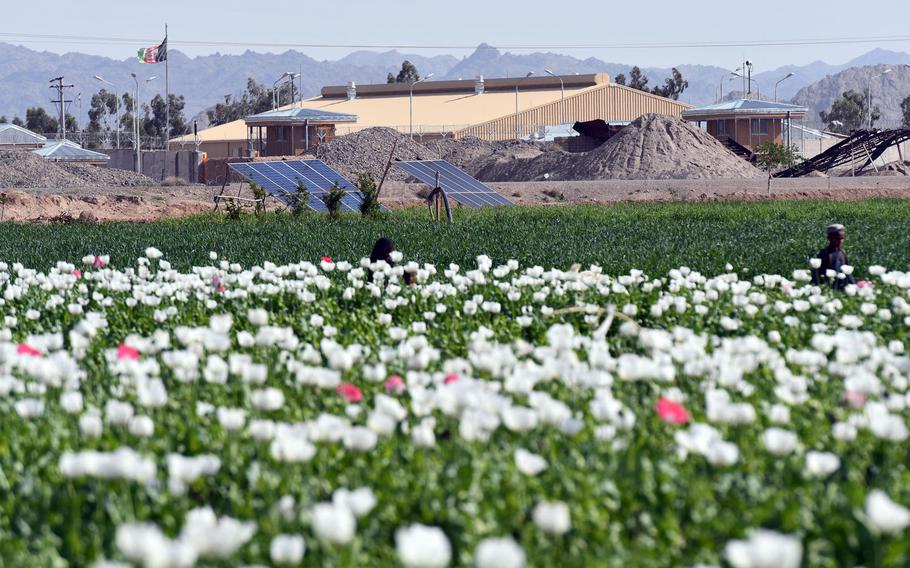
Opium poppies grow near a police station in Zhari district, Kandahar province, on April 9, 2019. Although the acreage planted to poppies in Afghanistan fell last year, the country could produce one of the largest yields of opium in recent years, U.S. government data show. (Phillip Walter Wellman/Stars and Stripes)
KABUL, Afghanistan — Afghanistan could see one of the highest yields of opium in nearly a decade, even though land totalling 146,000 fewer acres — the equivalent of 111,000 football fields — was planted to poppies last year, White House estimates show.
While land used to grow poppies in Afghanistan declined by nearly 30% between 2018 and 2019, the amount of opium extracted from the flowers’ seed pods likely increased by more than 20%, the White House Office of National Drug Control Policy said Friday, citing estimates of both cultivation and opium production.
Despite the spending of billions of dollars by the U.S. since 2001 to combat Afghanistan’s lucrative drug trade, the country continues to be the world’s largest grower of the poppy from which opium and heroin are produced.
Ninety percent of the world’s opium and 80% of the world’s heroin come from Afghanistan, the U.N. has said.
“Although heroin originating from Afghanistan is not a driving force of the United States opioid epidemic, drug revenue generated by insurgents prolongs insecurity and fuels corruption,” the ONDCP said.
The country’s drug trade has ballooned since U.S.-led forces invaded the country in 2001 and toppled the Taliban, who banned poppy cultivation.
The opiate economy in Afghanistan was valued to be between $1.2 billion and $2.2 billion in 2018 and represented between 6% and 11% of Afghanistan’s GDP, said a report by the U.N. Office on Drugs and Crime.
The estimated 6,700 metric tons of pure opium produced in Afghanistan last year would mark the second-highest yield in nearly a decade, exceeded only by the 9,140 metric tons recorded by the ONDCP in 2017.
“Favorable weather and harvesting conditions” led to the higher yields, the ONDCP said, warning that the sharp rise in opium production in Afghanistan will have an impact around the world.
“The consequences of Afghanistan heroin trafficking are felt by the citizens of Afghanistan and countries along worldwide drug trafficking routes,” it said.
Plants grew significantly bigger last spring than during the same period the previous year, poppy farmers in Kandahar province told Stars and Stripes in April.
Many Afghan poppy farmers have said that even though it’s illegal to grow opium poppies, they are the only crop that provides them with enough income to feed their families. They sometimes pay bribes to Afghan officials so they will turn a blind eye and allow them to cultivate the lucrative crop, they said.
“The United States Government will continue its work to enhance its longstanding partnership with the government of Afghanistan to address this serious problem,” the ONDCP pledged.
wellman.phillip@stripes.com Twitter: @pwwellman